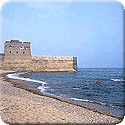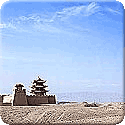Category: 收集品Collection
工艺品Arts and Crafts
-


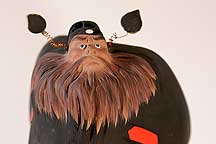
北京市 - 钟馗Beijing city - Zhong Kui
This turned out to be the legendary demon vanquisher 钟馗Zhong Kui. A story has it that during the 唐朝Tang dynasty (618 - 907), the emperor 明皇Ming Huang had a dream in which he withnessed a little demon stealing his jade flute and his favorite 杨贵妃Yang Guifei's perfume bag. But before the thief got away, a larger ugly demon in official clothing appeared and captured it. He then gouge the poor little demon's eyes and ate it. After witnessing this gross act, the emperor wants to know who he is. Our hero introduces himself as Zhong Kui. He had came to the capital with a friend for the imperial examination, but although he proved to be the first in the class, the title was withdrawn from him due to his unpleasant appearance. Seeing the unjustness he committed suicide right on the palace hall. As a demon he vowed to rid of all the empire's bad demons. The emperor then woke up. Immediately he summoned the great painter 吴道子Wu Daozi to render an image of this good ugly demon-official and have it spread throughout the empire. So, from Tang onward, many households had posters of Zhong Kui on their doors to repell bad demons. Made of clay and hand painted.
-



武汉市 - 月下饮酒Wuhan city - Two Drinkers
Also made of clay and painted. Two commoners enjoying a meal, perhaps under the moonlight. Their extraordinary expressiveness made them very identifiable. The set comes in several pieces, including the two men, a stone platform, two dishes of food, two cups and two kuaizi (chopsticks). I got the set at 武汉市Wuhan city's 黄鹤楼Huanghelou (Yellow Crane Tower) in 2001 when I was there. It had to be moved from there to my village, and from my village I lugged it around to 广州市Guangzhou city; then check in on the plane back to New York. I forgot at which stage the arms broke off.
-



北京市 - 官人,酒鬼Beijing city - Official, Drunkard
Painted clay. On the left is an official, very likely a corrupted one, rocking leisurely on a large gold nugget. On the right is a drunkard in the shape of a wine pot.
-


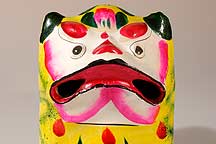
济南市 - 虎Jinan city - Tiger
Hand painted ceramic figure of a tiger with a leather bellow on its mid-section. Because of the bellow, as you push the tiger head a little, air comes out of the two-holed mouth and produces a sudden "oong" sound. The tiger subspecie 华南虎South China Tiger, which many believes to be the antecedent of all tigers, was native to south China. So, since antiquity the solitary tiger has been revered to the point that it was elevated into a mythological symbol. It is one of the 四象Four Symbols of the 五行学Five Elements system of thinking. As the White Tiger (white here does not mean the color of the tiger's skin, but the symbolic color of the direction) it is the guardian of the direction "west" and the season "autumn". Tigers are believed to be the king of all beasts. They are in fact the largest of all cats. So recognized that it is the adopted form of the imperial tally used to authorize imperial instructions, particularly military instructions. The tiger tally is divided into two halves, whereby they must match for the instructions to be authentic. Unfortunately, today the South China tiger is in grave danger of extinction.
-



济南市 - 猪Jinan city - Boar
Colorful threads were sewn onto the stuffed cloth body to define the details of this seemingly tamed boar.
-

都斛 - 酒杯Duhu - Drinking Cup
While I was in my mother's village last year (2006), I went into her father's old house. Since my grandfather's passing several years ago, this was the first time I was able to go in and take a good look. It was one of the oldest house in the village, dating back to the early Republican era (1912-1949). It was built by his grandfather, who was a merchant. And because of his trade and because of the chaotic times, he was wary of bandits who often raided villages; so, he dugged a tunnel that led to outside the village. But unfortunately the folks said that the tunnel had collapsed and a brickwall had sealed its entrance, so I cannot examine it. The house has a low second level, a sort of attic. A very narrow staircase leads up to it. After some time looking over some of the remains, I found this cup which I liked very much. I don't know the exact date, but it was very likely from my great-grandfather's time.
-


都斛 - 清币Duhu - Qing Coin
Besides the above cup and I also found this 清朝Qing dynasty (1644-1911) coin and the Mao buttons below. The coin has the Manchurian characters (left photo) on one side and the Han characers on the other. There were two other coins but this one was best preserved. Qing coins are quite numerous in the market, although many are fake. Currency was standardized during the first empire; the circular copper coin with a square hole in the center had been in use til the last century, more than 2000 years. The circular shape represents Heaven, the square hole, Earth.
-
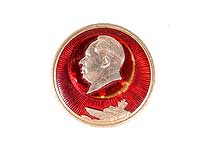

都斛 - 毛泽东钮Duhu - Mao Buttons
You can find these buttons in most tourist areas. They come in various sizes and designs. Although I never bought one I always liked their iconic look. And so having found these it was enough.
-



唐模 - 茶道用具Tangmu village - Tea Ceremony Utensils
A set of utensils used for tea ceremony. They were carved out of solid bamboo and are extraordinarily detailed and delicated. Unfortunately they are irresistable to the tastes of termites. And since 2004 these tiny folks had colonized it. I had to get rid of them for these photos.
-

西安 - 茶壶Xian - Teapot
I got this tiny burnt-ochre-color teapot in a sort of flea market by Xian's city walls. The seller was from the well-known ceramic town 景德镇Jingdezhen in 江西省Jiangxi province; about twice a month he would come to the old capital for a few days to sell his wares. It is made of special hard porcelain that has a sharp ring when tap at. Porcelain production was already active during the 商朝Shang dynasty (16th - 11th).
-



济南市 - 美人葫Jinan city - Beauty on a Gourd
I was told that a hot rod was used to mark the lines of this beauty sitting by the rocks. The dark brown burns seems to be evident of that. It is a large perfect gourd, about 40cm high.
-


苏州市 - 扇子Suzhou city - Folding Fan
This well-made fan was made specifically for painters. The paper ends are not glued to the wood pieces, which makes it more flexible for the artist. After the artwork is completed it can then easily be glued together. This particular one has better wood and paper, but I discovered a fan-making shop while I was lost in the mazes of old alleys near the birthplace of the great Ming (1368-1644) painter 唐寅Tang Yin. At the entrance gate was hung a birdcage, instead of a dog, and this orange-breast bird chirped loudly when I sneaked in. The building layout was classical: A big empty courtyard in the center, and on four sides are the rooms. A man and two women were assembling fans at a leisure pace and weren't very taken by my sudden visit. I expressed my interest in the craft, and they happily showed me around. The workplace had three rooms: one room for hanging wet glued paper, another room for glueing, the middle room for assembling the pieces. In the middle room were drawers of handles, all standardized, of wood and bamboo. These handles were made elsewhere and they are of good quality. The paper can be plain or speckled. Of course I bought a bunch before I left.
-


绍兴 - 梳子Shaoxing city - Wood Comb
The combs here were made by a brand name company that specializes in combs.
-
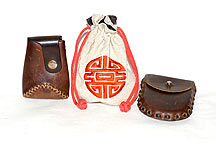
乌鲁木齐市,南京市,太原市 - 钱包Wulumuqi city, Nanjing city, Taiyuan city - Money Pouches
Gold, silver and copper weights as well as copper coins and paper money came early in China. Naturally, portable pouches were made to hold them.
-

西安市 - 司南Xian city - Lodestone Compass
Magnetism had been know in China since early times. In the book 《管子》"Guanzi", written during the 战国Warring States Era(475 - 221), there is this passage:
山上有磁石者,其下有金铜。
Atop the mountain are lodestones, below are metals.**
秦始皇Qin Shihuang had this story involving magnetism: After the establishment of the First Empire, the emperor was obsessed with protecting himself. Even though he forbade anyone in court to carry metal weapons under the pain of death, his fear still did not subside. So in the middle of the palace, he secretly ordered its door to be made of lodestone. Anyone with a metal object would then be stuck to it and will be subjected to severe punishments.
The use of natural magnetic lodestone for compasses came not far behind. For a long time the common name for the lodestone compass was 司南Si Nan(South Pointer). In the book 《鬼谷子》“Book of Demon Valley", also of the Warring States Era, it states that when the citizens of 郑Zheng go out in search of jade, they bring along the 司南Si Nan(lodestone compass) so they would not get lost. A later book, 《韩非子》"Han Feizi" Written at the time of first emperor by the Legalist philosopher Han Fei, it states:
先王立司南以端朝夕。
Our lord set the order of things as like the Si Nan.**
We have this description of the instrument, from 王充Wang Chong's 《论衡》"Lun Heng" of 东汉East Han dynasty:
司南之杓,投之于地,其柢指南。
South pointer's ladle, when placed on the ground (board), its root (ladle handle) will point south.**
Further elaboration of the instrument was as thus: The lodestone is shape as a ladle, representing the Great Bear. It rests on a polished circular area representing the heaven; this circular area is on the center of a square board made of bronze, representing the earth. The board or earth-plate is divided into the eight directions using 八卦Bagua symbols and the twenty-four houses. The instrument's early use was primarily for geomancy. It was not til the end of the 唐朝Tang dynasty that the navigational use for sea was attempted. By that time magnetized steel needles, first in the shape of a narrow fish, replaced the lodestone. The needle first floats on a bowl of water, then later suspends or rests inside a box. Its points south. And needless to say it also points north if one happens to pick up the foreign instrument for the first time and understood not a single character written on it.
Acording to the booklet that came with the above pictured lodestone compass, it's earth-plate was modeled after an original laquer earth-plate that was unearthed in 乐浪Lelang(Chosen, Korea). This replica of mine has a bronze (a metal that is not susceptible to magnetic influences) earth-plate and a lodestone ladle. The ladle is carefully polished on its underside, as is its resting circular area. The handle always points south.
-


杭州 - 孔明锁Hangzhou - Kong Ming lock
The puzzle is said to be the invention of the great premier and strategist of the 三国Three Kingdoms Era (220 - 280). 孔明Kong Ming or 诸葛亮Zhuge Liang was the premier of the 蜀国Shu kingdom, whose king, 刘备Liu Bei, was the legitimate heir to the 400 year long 汉朝Han dynasty (202 - 220). But unfornately during this chaotic times, two other warlords also vied for the throne. It was much to the premier's credit that the three kingdoms were divided as such so that the small Shu kingdom in the Sichuan region did not get gobbled up so soon. He made six great military expedition against the most powerful and threatening of the three, the 魏国Wei kingdom whose regent was 曹操Cao Cao, to regain the northern territories. But the Wei army was more than a million strong, more than 10-20 times his. He died in vain during his sixth expedition (234). But his loyalty, statesmanship, and especially his ingenius military strategies had won him deity-level reverence. Folk stories and legends had been passed down orally about that chaotic times of loyalty, betrayal, intrigues and chavalry and were pieced together during the Ming (1368-1644) times into 三国演义Romance of the Three Kingdoms, one of the four great novels of China. Much of the novel concerns him. And his famous military designs were known to people of all ages. Since his time, his name is synomous with intelligence. This mind-exercising toy was said to be created by him according to the 八卦Bagua principle. Athough it is possible that he has time off to diverge from his busy schedule to fool around with a toy or maybe during his youth, it is very likely that his famous name was borrowed instead. He is also credited with the invention of the wheelbarrow, but that invention was already around more than a hundred years earlier. However, he may have been the first to apply it to military use. Since the establishment of the 中华人民共和国People's republic (1949), many folk arts and crafts, literature, music, and others were researched, collected and revived, among them are mind toys and games. I bought this at a outdoor market in 杭州市Hangzhou city. Every night several long streets were closed for this market which sold everything, including many mind toys, games and puzzles. This set has six pieces of the same dimensions: 2 identical pieces, two mirrored pieces and two unique pieces. Each set of two pieces intersect one another perpendicularyly so that all sides are identical.
-

苏州市 - 针线盒子Suzhou city - Sewing Kit
A case containing a sewing kit which includes needles, threads and a scissor. The colorfully-dressed child is playing ball or soccer, a sport that has its origin in China. According to 《别录》"Other Records" written possibly by 刘向Liu Xiang of the 西汉Western Han dynasty (202 - 8 AD), the game 蹴鞠Cuju(literally, kick ball) had been in existences since the 黄帝Huangdi (Yellow Emperor) 4600 years ago, and by the 战国Warring States, there are definite evidence:
蹴鞠者,传言黄帝所做,或曰起战国时。
Cuju, legends has it that the Yellow Emperor invented it, or has its origins during the time of the Warring States.**
During the Warring States, in the kingdom of 齐国Qi (today's Shangdong province), the Cuju was commonly played in its capital 临淄Linzi. Both the 《战国策·齐策》“Warring States strategy - Qi strategy" and the 《史记·苏秦列传》"Histrical Records - Su Qin Biography" have records of this.
临淄甚富而实,其民无不吹竽、鼓瑟、击筑、弹琴、斗鸡、走伏、六博、蹋鞠者。
Linzi is evidently prosperous, not a single of its citizens does not play the flute(?), pluck the se, .., stroke the qin, have rooster fights, race dogs, .., or Cuju.**
By the Han dynasty the game was very common. 鞠ju, the word for the game's ball, had specialize makers. The outer material was leather, the inside was stuffed with hair or feathers. Other ball designs also appeared and became popular, such as water balls, rattan balls and bamboo balls. At this time, the military employed the game for drilling as well as for recreation. Regulations were developed for competition. At court, the game was vehemently played by officials. Special 鞠城Jucheng, rectangular walled ball courts were designed for the game. According to the 东汉East Han writer, 李尤Li You who wrote in 《鞠城铭》Juchengming (Ball Court Inscription) describe the game as having two teams of 12 players each with referees; on each end of the court were 6 small moon-shaped 鞠室ball rooms(goals). Not only did men played, women were also hotly engaged in the sport. Players were so passionate of the game that in one recorded incident, a Cuju fan by the name of 项处Xiang Chu refused the advice of a doctor and went out to practice Cuju. He died as a result. This was recorded in 《史记·扁鹊仓公列传》"Shiji - Bian Que and Cang Gong Biography":
名医淳于意为项处看病,叮嘱他不要过度劳累,但项处不听,仍外出踢球,结果呕血身亡。
Doctor Chun Yuyi examines Xiang Chu, urges him not to overexert; but Xiang Chu does not listen and goes out to play Cuju. As a result he vomits blood and dies.**
By the end of the Han, the sport had spread to all parts of the empire, including minority regions. During the 唐朝Tang dynasty (618 - 907), Cuju reached a new height. The ball became air-filled instead of hair-filled. The previous 鞠室ball room (goal) was transformed into poles with a net, and were placed on opposite ends; whoever gets the most balls into the goal wins. At this time women players were common, as were common people and emperors; Emperor 太宗Taizong and 玄宗Xuanzong were know to have played. It was during the metropolitan Tang that the sport effectively spread outside of the empire.
Cuju reached it height during the 宋朝Song dynasty (960 - 1279). By that time, Cuju associations such as 齐云社"Qiyun Association" or 圆社"Yuan Association" was established. National competitions were held and prizes were awarded. In the 《蹴鞠图谱》"Cuju Manual" various styles and techniques of kicking were described. In one list of players found in 《武林旧事》"Wulin Old Records" there were 16 players per team with names of head players, goal players and others of various positions and responsibilities.
After Song, Cuju went on its decline. During the 元朝Yuan dynasty (1271-1368), the Mongols rather promote horse-riding games, and although it continued to be played by the lower class, it declined rapidly in the mainstream. By the 明朝Ming dynasty (1368-1644), Cuju was prohibited from playing in the military. Its use was then mostly for leisure and individual play as well as a children's game, not competition. The next dynasty, the foreign清朝Qing (1644-1911) were northerners, they rather play games on ice. Cuju was transformed into a game on ice, probably like hockey. Thus through dynastic changes and persecutions, Cuju development declined and finally stopped.
-


武当山 - 口哨子Wudangshan - whistle
I believe I got this bamboo whistle at 武当山Wudanshan mountain. At one end is a metal wire handle with cotton wrapped on the inside end. Pushing and pulling it in and out while you blow will change the pitch. A few dabs of paint gave it character.
-


杭州 - 笛子Hangzhou city - Dizi
The Dizi (flute) or Hengdi (horizontal or traversal flute) had a long history in China. Archaelogical finds in 河南省Henan province had shown that playable bone (from the legs of the Red Cranes) flutes of 5-6 holes tuned to the pentatonic scale had been around between 8000 and 9000 years ago. These are the earliest known playable flutes in the world. At another site in southeast 浙江省Zhejiang province a six-holed traversal (meaning the blow hole is on the side along with the other holes as oppose to the flip side which is on the end and blow like a whistle) flute was found to be between 5000 - 7000 years old. For more detailed information and bone flute images as well as other Chinese musical instruments take a look at this in-depth site, chineseinstruments.org. This bamboo Dizi is in two pieces joined by steel ends. The blow end is blocked by cowhorn while the other is free.
-

黄山市 - 印章Huangshan city - Seal Stone
I got this large seal stone somewhere near Huangshan mountain. Although the use of seals had an ancient history in China, the use of stone as the media for seals was much later. Before stone, metals were mainly used. The first use of stone was credited to the great 元朝Yuan (1271-1368) artist 王蒙Wang Meng. Starting from the late 明朝Ming (1368-1644) onward, sealcarving developed rapidly and became a common practice among artists. Perching on top of the stone is a lion. Lions were introduced to China during the Han dynasty following the inception of Buddhism in this country at that time. This Buddhist animal gain wide popularity when the religion prosper during the chaotic times between the Three Kingdoms Era and the unified 隋朝Sui Dynasty (581 - 618). It has remain in the stable of mythical and symbolic animals in China since its appearance. Its main use was as a guardian, mainly of temples and tombs, such as these lions that guards the royal tombs of the 六朝Six Dynasties (220-589) near 南京Nanjing city.
-

黄山市 - 徽墨Huangshan city - Hui Inkstick
-





砚台Ink Stones
Inkstone or inkslab, along with the inkstick, was first used during the 汉朝Han dynasty when paper for writing was beginning to be used. In the above inkstones, the first three gray stones are 歙砚She stones, the last two dark red-brown stones are 端砚Duan stones from 广东省Guangdong province. They are two of four main stones use by inkstone makers.
-









成都, 北京,扬州,湖州 - 毛笔Chengdu, Beijing, Yangzhou, Huzhou - Brushes
Primative stiff brushes had been around since neolithic times, but during the time of the Warring States (475 - 221), softer ones were developed. A few centuries later the great 秦朝Qin (221 - 206) general 蒙恬Meng Tian, was said to made a significant improvement on the tool. He took goat or rabbit hair and used that as the writing tip. Its soft pliable writing tip fascilitates the writing of the 小篆Small Sealscript type, characterized by its elongated shape and fine rounder curves, which soon replaced the more rigid 大篆Large Sealscript type and became the standard of the new empire. It may have been that during the Great Wall construction campaign in the Ordos region, where goats abound, that he or someone else came across the idea of tying fine goat hair together for use as the writing tip of the brush. He then brought the improved brush back to the uncultured Qins. The 史记"Shiji"(Historical Records) has this to say:
恬取中山兔毛造笔
Meng Tian took Zhongshan's rabbit hair to make brushes**
All these, of course, may be legend. But the fact that his name has been associated with the brush and that today he is still regarded as a brush deity by brushmakers tells us much about the man - that he was capable at battle as well as at the finer things in life. In the above brushes, the third from the end is called 蒙氏羊豪Meng's goat hair.
Meng Tian was an unusual figure. Six years into the first unification of the empire (215), he led a 300,000 strong army up north to repel the 匈奴Xiongnu (the ancestors of the Huns), who had crossed the 黄河Yellow river and settled in the Ordos region, He drove them back out of the river and 700 li (about 300 km) into the Gobi desert. From what can be learned of from the Terracotta Armies in Xian, his army was made up of mainly foot soldiers, a large cavalry, and a few chariots; and his main weapon against the horse-riding nomads with their expert bowmanship was the crossbow gun, invented at least 200 years earlier but only recently perfected the complicated 4-piece trigger-mechanism that is casted in bronze. These crossbows were mass-produced, numbering 50,000 or more. At the same time he was responsible for the construction of the 万里长城Great Wall, by linking the existing walls of the 秦Qin, 燕Yan, and 赵hao with new ones; and he was also responsible for the construction of the 秦直道Qin's Straight Road, a highway from Inner Mongolia straight down to the capital in 咸阳Xianyang. As a general, he must bave been involved in the subjugation of the six other kingdoms to create the new empire; and later, in chasing the Xiongnu and building the Wall and the highway. His life would have been in constant run. But the Qin empire was short. The restless first emperor, 秦始皇Qinshihuang, died during one of his inspection tours (210). The prime minister 李斯Li Si and the high eunuch 赵高Zhao Gao, both of whom were travelling with the emperor, kept the death of the emperor a secret and then conspired to have the crown prince, who was sent to the general's camp to gain experience and credibilty, and Meng Tian poisoned for disloyalty. The crown prince 扶苏Fu Su and the general were close; so if he were to become the new emperor, their positions would be at risk. They wanted to put the weak second prince on the throne instead. The prince and the general were taken into custody and when poison was presented to them Meng Tian was suspicious and adviced the prince not to do anything; but the prince eventually committed suicide. Meng Tian resisted. Upon the news of crown prince's death, the second emperor wanted to release Meng Tian, but Zhao Gao feared Meng Tian and his younger brother 蒙毅Meng Yi, who was also a general but reponsible for internal security, spoke ill of them and wanted them dead. The gullible emperor listened. Meng Yi was executed. Then, an emissary was dispatched to the prison of Meng Tian for his life. When told that he had committed crimes, the general remarked,
自吾先人,及至子孙,积功信于秦三世矣。今臣将兵三十余万,身虽囚系,其势足以倍畔,然自知必死而守义者,不敢辱先人之教,以不忘先主也。
For three generations my family has served the Qin state. I am now the commander of three hundred thousand troops. Although I am imprisoned, I have enough power to rebell if I so desire. But I will not do that even upon death, for out of respect of my ancestors and remembrance of the First Emperor.**
The general then recited a historical precedent, a related story about 周公Zhou Gong, unfortunately the official showed no understanding. In the end he demanded,
我何罪于天,无过而死乎?
What crime have I commited to deserve death?**
After a moment of reflection, he signed:
恬罪固当死矣。起临洮属之辽东,城爎万余里,此其中不能无绝地脉哉?此乃恬之罪也。
I do deserve death. From Linyao to Liaodong some ten-thousand li I have constructed the Great Wall, I could not have avoided scarring the earth. This is my crime.**
Having said that he took the poison.
In his chapter on Meng Tian in his 史记 Historical Records, from where the above quotes were taken, the Grand Historian 司马迁Sima Qian (135 - 90) blamed him for not using his unique influence to prevent the tortuous undertaking (the construction of the Great Wall and the Straight Road) that cost the suffering of so many people. "It is not about the scarring of the earth" the great Han historian wrote. But the Han dynasty built the longest Great Wall. From the point of view of a general who had constant battle with the mobile invaders, he must have realized the military effectiveness of the Great Wall. The Grand Historian wrote at about a hundred years from the time of the general's death, during the reign of 汉武帝Emperor Wu Di (156 - 87). We do not know of his source, but it is imaginable that those words could have been said.
Had he refused to die, had the crown prince became emperor, history might have changed. As a great and experienced commander, he would have been able to put down the early rebellions led by 项羽Xiang Yu and the eventual victor刘邦Liu Bang, who established the long 汉朝Han dynasty. But three years after his death Xiang Yu enter the capital in 咸阳Xianyang and set fire on the newly-built palaced. The palace complex was afire for three months. Meng Tian died in the Ordos region in today's 陕西省Shaanxi Province. His tomb is in 绥德县Suide county. When I was there(2006), work was in progress to renovate the area, probably turning it into a tourist site.
-


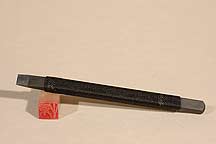


成都,北京, 杭州 - 刻刀Chengdu, Beijing, Hangzhou - Carving Knife
I am surprised at the number of different sealcarving knives, so whenever I saw a interesting piece I would get it.

南京市 - 枕头Nanjing City - Pillow
A colorful bed pillow with both ends having the face of a tiger. Tiger is the animal of choice for many things; it is one of the few animals that attained mythical status. The pillow is cylindrical -- the best and most comfortable shape for your head (mostly your neck, actually) to rest on, even if the pillow is made of porcelain. Here, the pillow is filled with dried plant stalks, usually some sort of herbs, but I can't tell for sure. These pillows are very popular. They come in different sizes, colors, and animal faces, depending on the location.

上海嘉定区南翔镇 - 拖鞋Shanghai - Slippers
A pair of hand-made local slippers made of dyed stalks -- probably wheat stalks. In 2004, I was in the town of Nanxiang in the Jiading district of Shanghai looking over the ancient 南翔寺双塔Nanxiang Temple's Twin Towers. The pair of brick towers had a history going back to the 南朝梁天监年间Southern Dynasty's Liangtianjian time (502 - 519). As I walked through the old town, which got its name from the temple, I found this shop that sells stalk slippers of all colors and shapes. I walked out with 2 pairs. Back in New York, I wore out the most decorative pair. I am leaving this pair untouched.


凤凰城 - 小包,钱包Fenghuang Town - Small bag, Money Bag
You can find these exquisitely hand-sewed bags everywhere in the town. Often the artist will be producing the works on site, and you may even have something custom made if you request it. Crafts and artworks like these have their local distinctiveness, with local imageries and designs, that is unlike similar products elsewhere, so get some while you are here.



凤凰城 - 萧Fenghuang Town - Xiao
This is a bamboo Xiao -- a vertical end-blown flute. The Xiao is one of the oldest music intruments in China, dating back to the time of bone flutes or whistles during the Neolithic Period. I was in a music shop by the touristy river area, and I saw this Xiao, which has the stocky root end of the bamboo, so I got it. It has a somber and low pitch tone that I like. In most cases, if you want a quality instrument, you should get it in a professional shop -- especially a sophiscated instrument like the 古琴Qu Qin. Of course, if you know your stuffs, you can get anything to suit your style. I am not a musician, but I like music intruments. Everytime I was in New York's Metropolitan Museum of Art, I always drop by the Chinese Music Intrument galleries.

凤凰城 - 木钗Fenghuang Town - Wood Hairpin
For many women, hairpins are a timeless favorite. These come in an exhaustless array of designs, shapes, colors, and materials. This hairpin is made of shellaced wood, a much more economical material, which is also much easier to shape.




